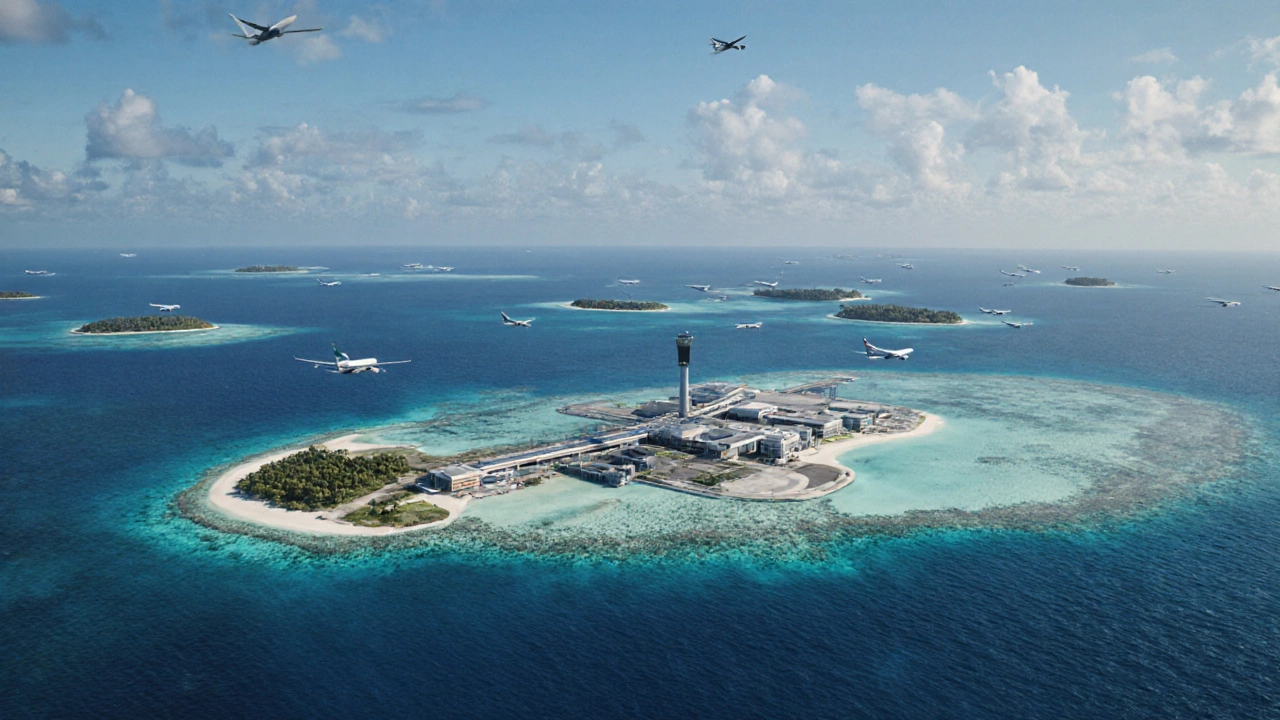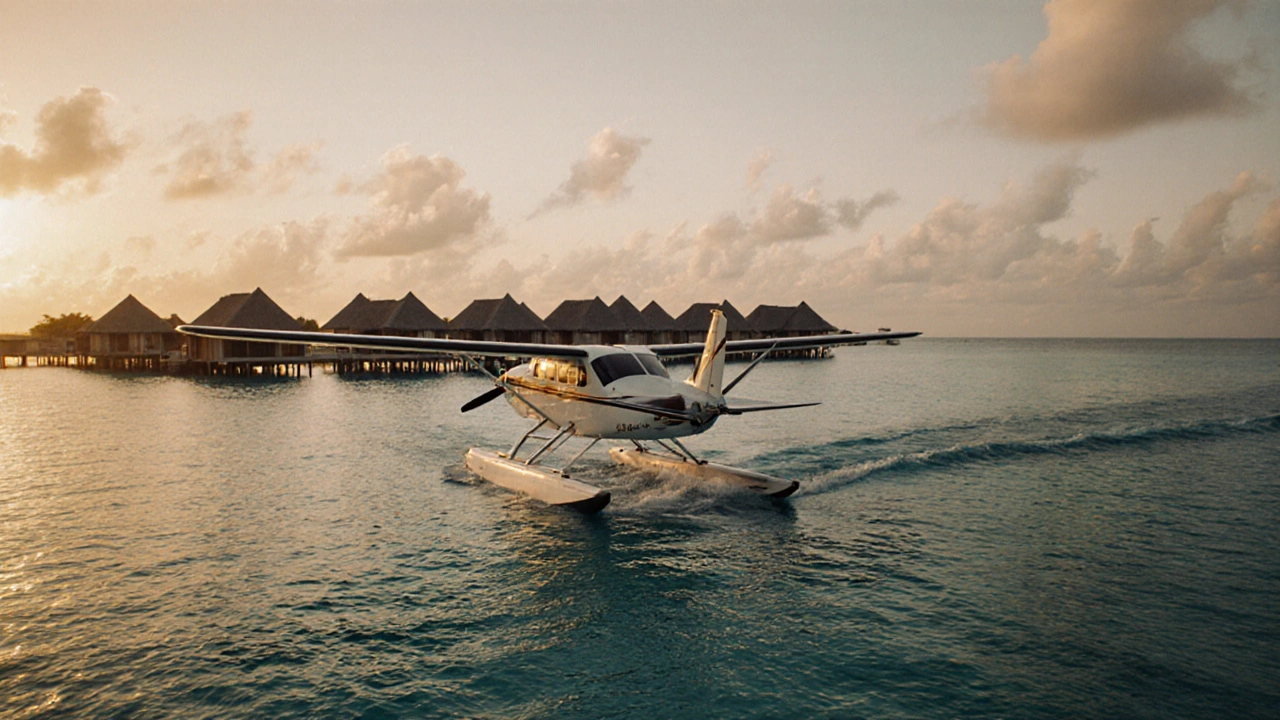Why Are Flights to the Maldives So Expensive?
 Oct, 28 2025
Oct, 28 2025
Maldives Flight Cost Calculator
If you’ve ever searched for flights from India to the Maldives, you’ve probably seen the sticker shock. A round-trip ticket that costs ₹25,000 in December might jump to ₹65,000 in January. It’s not just you-this isn’t a glitch or a scam. The Maldives isn’t just expensive because it’s a luxury destination. The real reasons are deeper, and they’re tied to geography, demand, and how the entire system is built.
The Maldives Is Hundreds of Miles From Anywhere
The Maldives isn’t just a tropical island. It’s 1,190 coral islands spread across 90,000 square kilometers of ocean. That’s bigger than Sri Lanka, but with almost no land to build on. There’s no major airport hub nearby. The only international airport-Velana International (MLE)-serves the entire country. That means every flight has to fly directly from distant cities like Delhi, Mumbai, or Bangalore. No connecting flights through Bangkok or Dubai save you money here. Airlines can’t spread costs across multiple stops. They have to fly point-to-point, which costs more per passenger.
Compare this to Bali. You can fly from Delhi to Bali via Kuala Lumpur or Singapore, and airlines compete on those routes. In the Maldives, there’s no competition. Only a handful of airlines fly direct from India: IndiGo, Air India, Maldivian, and a few seasonal charters. With limited options, prices stay high.
Seasonal Demand Cranks Prices Up
From November to April, the Maldives is in peak season. That’s when India’s winter hits, and families look for warm beaches. Delhi and Mumbai alone send over 300,000 tourists to the Maldives each year during this window. The Maldives government caps the number of resort islands-only about 150 are open to tourists. That means limited beds. When demand outpaces supply, prices don’t just rise-they skyrocket.
January is the most expensive month. Why? Because it’s the perfect weather window: no rain, calm seas, and clear skies. Indian travelers also time their trips around New Year’s and school holidays. Airlines know this. They don’t lower prices to fill seats-they raise them to maximize profit. A ₹35,000 ticket in October can become ₹85,000 in mid-January, even if it’s the same flight.
It’s Not Just the Flight-It’s the Whole System
Many people think the high cost is just the plane ticket. But the real expense starts before you even board. Resorts in the Maldives are built on private islands. To get there, you need a speedboat or a seaplane transfer. These aren’t free. A seaplane ride from the airport to your resort can cost $300-$600 per person, round-trip. That’s added to your ticket price, but it’s not always included.
And here’s the catch: most resorts sell packages. You can’t just book a flight and a room separately and save money. The resorts bundle everything-accommodation, meals, transfers, even water sports. That’s because they need to guarantee revenue. If you try to book cheap flights and stay at a budget guesthouse on a local island, you’ll find those options are limited and often don’t have direct flight access. Most local islands aren’t connected to the international airport. You’d need to take a domestic flight first, then a boat. It’s possible, but it’s not what most travelers want.

Infrastructure Costs Are Built Into Every Ticket
Running an airport on a tiny island in the middle of the Indian Ocean isn’t cheap. Fuel has to be shipped in. Every spare part, every bottle of water, every meal served in the terminal had to be flown or shipped from thousands of kilometers away. The Maldives imports over 90% of its goods. That cost shows up in everything-airport fees, landing charges, even the price of a coffee at the duty-free shop.
Airlines pay higher fees to land at MLE than they do at bigger hubs. Those fees get passed on to you. Add in the cost of maintaining runways on coral sand, dealing with high humidity, and the need for specialized equipment, and you’ve got a system designed for profit, not affordability.
There Are No Budget Airlines Flying Direct
Low-cost carriers like Ryanair or SpiceJet thrive on high-volume, short-haul routes. The Maldives route doesn’t fit that model. The flight from Delhi to Male is about 3,500 kilometers-longer than Delhi to London. That’s too far for most budget airlines to operate profitably. The aircraft used (like the Airbus A320 or Boeing 737) burn more fuel on longer routes. Fuel costs alone can make up 40% of the ticket price. When you add in airport fees, crew costs, and maintenance, there’s no room for low fares.
Even IndiGo, India’s largest low-cost carrier, charges premium prices on Maldives routes. Why? Because they know travelers are willing to pay. There’s no real competition from other budget airlines. If you want a cheap flight, you’d have to fly to Sri Lanka or Thailand first, then take another flight. That adds time, hassle, and often ends up costing more than a direct ticket.
What About Off-Season? Can You Save Money?
Yes-but it’s not simple. The monsoon season runs from May to October. Rain is frequent, seas are rough, and some resorts close. But if you’re flexible, you can find deals. Flights in June or September can be 40-60% cheaper than in January. Some resorts offer “monsoon specials”-free transfers, discounted spa treatments, or extra meals.
But here’s the trade-off: you might get rain for half your trip. If you’re planning a honeymoon or a photo-perfect beach vacation, that’s risky. Most Indian travelers aren’t willing to gamble. That’s why demand stays high even in shoulder seasons. Airlines don’t need to drop prices-they know people will pay.
Is There a Cheaper Way to Get There?
There’s one option: book through a travel agent who bundles flights and stays. Sometimes, they negotiate group rates with airlines and resorts. You won’t find these deals on Google Flights or MakeMyTrip. You need to ask. Some agents in Mumbai or Delhi specialize in Maldives packages and can save you ₹10,000-₹20,000 per person.
Another trick: book early. Flights open up 11 months in advance. The first 20 seats on each flight are often priced lower. If you lock in a ticket in February for a December trip, you can save up to 50%. But you need to commit early. Waiting until November means you’re paying peak prices.
And if you’re okay with a longer journey, try flying to Colombo or Dubai, then connecting to the Maldives. It adds 6-10 hours to your trip, but you might save ₹15,000. Just remember: you’ll need a transit visa for Sri Lanka or UAE, and you’ll have to manage two separate bookings. If your flight is delayed, you’re on your own.
Why Do People Still Go?
Because for many, it’s not about cost-it’s about experience. The Maldives offers something no other beach destination in South Asia does: total seclusion. White sand, turquoise water, overwater bungalows, and no crowds. It’s a place where you can’t see another resort from your balcony. For Indian honeymooners, it’s the ultimate escape from the noise of home.
It’s also a status symbol. Booking a Maldives trip says, “I can afford this.” And in a market where social media drives travel decisions, that matters. People don’t just want a beach. They want the Instagram moment. And that’s worth paying for.
Bottom Line: It’s Not Just the Flight
Flights to the Maldives are expensive because the destination itself is isolated, demand is intense, infrastructure is costly, and there’s no competition. The price isn’t just for the seat on the plane-it’s for the entire experience of getting there and staying. If you want to save money, book early, travel off-season, or consider a multi-stop route. But if you’re after that perfect, private island escape, you’re paying for something that simply can’t be cheap.
Are there any budget airlines flying to the Maldives from India?
No, there are no true budget airlines operating direct flights from India to the Maldives. Airlines like IndiGo and Air India offer the most frequent services, but they charge premium prices because of long distances, high operating costs, and lack of competition. Low-cost carriers avoid this route because it’s too far and too costly to run profitably.
Why are Maldives flights more expensive than flights to Bali or Thailand?
Flights to Bali and Thailand are cheaper because those countries have multiple international airports, more airlines competing on the route, and shorter flight paths from major Indian cities. The Maldives has only one international airport, no nearby hubs, and limited flight options. Plus, resorts there are built on private islands, which adds transfer costs you don’t face in Bali or Phuket.
Can I save money by staying on a local island instead of a resort?
Yes, staying on a local island like Maafushi or Thulusdhoo can cut your accommodation costs by 60-70%. But you’ll still need to pay for a seaplane or domestic flight to reach the island, and you won’t get the same amenities as a resort. Plus, local islands don’t have direct international flight access-you’ll still need to fly into Velana Airport first. It’s cheaper, but not as convenient.
When is the cheapest time to fly to the Maldives?
The cheapest months are May through September, during the monsoon season. Flights can be 40-60% lower than in peak season (December-April). However, expect more rain, rougher seas, and some resorts may be closed. If you’re flexible and don’t mind occasional showers, this is the best time to save.
Should I book my flight and hotel together or separately?
Booking a package through a travel agent often saves money. Resorts and airlines sometimes offer bundled deals that aren’t available online. If you book separately, you’ll pay full price for the flight and resort, and you’ll also need to pay extra for transfers. Packages include transfers, meals, and sometimes activities. Just make sure the package includes everything you need before you pay.